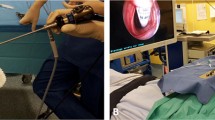Abstract
Objective: To present a new technique for non-surgical tracheostomy. Design: An open, clinical trial on patients requiring elective tracheostomy. Setting: Intensive care unit of a community hospital. Patients: 95 adults, mean age 60 years, and 14 infants and children, mean age 26 months (2 months–7 years) with common indications for tracheostomy. Intervention: Through a needle inserted in the trachea, a guidewire is pushed out of the mouth against the usual direction and attached to a special device formed by a flexible plastic cone with a pointed metal tip joined to an armoured tracheal cannula. This device is then pulled back through the oral cavity, larynx and trachea and outwards across the neck wall by the operator applying traction on the wire with one hand and counterpressure on the neck wall with the fingers of the other hand. When the cone and a part of the cannula have emerged, the cannula is cut off from the cone, straightened perpendicular to the skin, rotated and advanced caudally to its final position. Results: The cone-cannula passed smoothly through the vocal cords. The metallic point perforated the neck easily. The dilation did not present any risk of tracheal wall damage because the direction of the manoeuvre was from the inside to the outside of the neck. The tissues tightly adhered to the cannula, thus avoiding infection and bleeding. The use of ventilation systems permitted utilization of translaryngeal tracheostomy (TLT) even in patients for whom apnoea might have carried some risk, because there is no interruption of respiratory assistance during the procedure. Follow-up showed no late obstructive complication at the level of the tracheostoma. Conclusions: By virtue of its greater safety and less trauma to tissues than percutaneous techniques, TLT can also be carried out in infants and children (an important benchmark for any tracheostomy technique) and in very difficult patients from whom other techniques have serious drawbacks.
Similar content being viewed by others
Author information
Authors and Affiliations
Additional information
Received: 26 April 1996 Accepted: 26 November 1996
Rights and permissions
About this article
Cite this article
Fantoni, A., Ripamonti, D. A non-derivative, non-surgical tracheostomy: the translaryngeal method. Intensive Care Med 23, 386–392 (1997). https://doi.org/10.1007/s001340050345
Issue Date:
DOI: https://doi.org/10.1007/s001340050345




